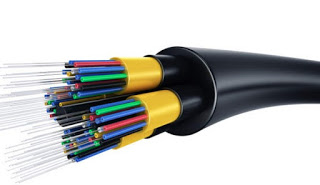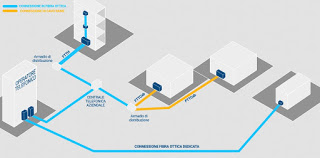Let’s look at the various types of FTTH fiber optics we can get when we sign up for a subscription for the ultra-fast line

But behind the FTTH type optical fiber (the fastest one), various types of technologies can be hidden, which identify different ways in which we are connected to the fast network or to the telephone exchange closest to our house. Before subscribing to any subscription, it is always advisable to inquire about the type of FTTH network we will be using: in this guide we will show you the types of FTTH fiber optics available, indicating for each one its strengths and weaknesses.
The next time you hear about fiber optics, you will surely be more informed about the subject.
READ ALSO -> Best Optical Fiber: coverage verification and offers
Currently, there are three types of FTTH fiber optic connections, which is the fiber that reaches the house (instead of the classic telephone socket, which uses copper for all or a good part of the way).
1) PTP type of optical fiber connection

The disadvantage is in the cost: the operator should dedicate a single fiber optic cable (which can usually serve up to 100 or more different users) to a single building, with very high installation and management costs. Another significant disadvantage is signal attenuation: without intermediaries, the fiber optic signal degrades rapidly as the distance covered increases (even if we are talking about a limit of 70 km of coverage, far from the limits of ADSL). This type of connection is in fact offered only to companies and multinationals, which can afford to pay all the accessory costs of having a dedicated optical fiber for the Internet connection.
2) AON type of optical fiber connection
For home users, the most connected connection involves the use of a fiber optic cable whose capacity is divided among all users via active or passive splitters, usually located in telephone exchanges or in cabins.
The first technology of this type is known as AON or Active Optical Network.
With this type of connection, we will have a fiber optic cable able to carry many signals at the same time (each signal is a user) up to the active splitter closest to the user: once they reach the splitter each signal follows its path, addressed directly from the splitter.
Following the example in the image above, if we are user A, we will only receive packets A from the nearest splitter.
The performances are very good (at least 10 Gbps) and the stability is just as good, since the signal can be amplified on arrival in the splitter, so as to be able to cover another abundant 20 Km (over 70 Km already seen for the dedicated connection, which in this case connects the operator to the splitter).
Obviously this type of network requires a lot of maintenance since the splitter is active (requires electricity and good isolation from external factors): management costs are higher than ADSL and FTTC, even if they are definitely lower than the PTP connection.
3) PON type of optical fiber connection
The “cheaper” version of the FTTH fiber optic is identified as PON or Passive Optical Network.
As can be easily understood, in this case, there are no active but passive splitters. With a passive splitter, we will not get the signal routing, but we will get propagation of all the signals to all the users connected to it. To better understand we follow the example shown in the image above: if we are user A, we will also receive signals B and V; our wall terminal (ONT) will only recognize the packets of our connection, passing only signal A and filtering signals that do not concern us or that we do not use.
With this connection, we will have good speed (up to 1 Gbps) and a fair stability, but the maximum coverage drops considerably compared to the other types of connection since the signal is not amplified: we can reach a maximum distance of 20 km from the operator. However, the operating costs are lower than the prices offered to users: currently, almost all Italian operators offer this type of connection for FTTH-type optical fiber, also identified as GPON (ie Gigabit Passive Optical Network).
4) Conclusion
As we have seen, there are many technologies that hide behind the simple FTTH code, which is the optical fiber that reaches home and replaces the old telephone socket. Everyone’s dream is obviously to have a dedicated fiber optic cable just for us, but for operators, it is obviously not very economical to do so (unless we have a company with at least 1000 employees).
The AON connection is the most logical solution to have a connection projected into the future, but many operators do not want to fragment the network too much to avoid having to pay technicians each time to maintain the active splitters, positioned in the telephone exchange or in a cabinet. Then the active splitters consume electricity and, if they do not need a sufficient number of users, they are anti-economic.
The PON connection is the most practical solution and that satisfies everyone (currently): the management costs are low (in fact just check that the cables reach their destination, since the passive splitters do not weigh too much on costs), the connection speed is still high for the standards current (1000 Mega per second, or 100 MB downloadable in a second!) and operators can pull the fiber without fragmenting the network too much, even if limited to 20 Km of maximum coverage.
The future will certainly include a mix of these technologies, so as to be able to bring optical fiber anywhere in Italy: for those sufficiently close to the operator in the big cities (ie to its building where the network backbone starts) it will be possible to exploit PTP connections, for suburban neighborhoods and for cities instead, the provincial capital will have AON connections.
For those who live in small towns, there will be PON connections, perhaps “connected” to an AON node in the larger inhabited center nearby: in this way it will be possible to bring at least 300-400 Mega per second to everyone, even those lost in the city by a few inhabitants, without having to spend capital to bring all the infrastructure required for the AON network.
The spread of PON will probably replace the current FTTC connections in the next 5-8 years, where the fiber optic signal arrives at the cabin and is reconverted to pass over the copper cable of the twisted pair.
READ ALSO -> VDSL, FTTC and FTTH fiber: which differences and which is better?
